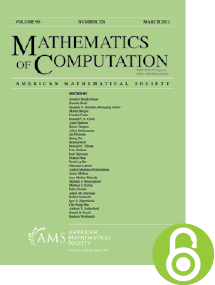The equilateral small octagon of maximal width
HTML articles powered by AMS MathViewer
- by Christian Bingane and Charles Audet HTML | PDF
- Math. Comp. 91 (2022), 2027-2040 Request permission
Abstract:
A small polygon is a polygon of unit diameter. The maximal width of an equilateral small polygon with $n=2^s$ vertices is not known when $s \ge 3$. This paper solves the first open case and finds the optimal equilateral small octagon. Its width is approximately $3.24%$ larger than the width of the regular octagon: $\cos (\pi /8)$. In addition, the paper proposes a family of equilateral small $n$-gons, for $n=2^s$ with $s\ge 4$, whose widths are within $O(1/n^4)$ of the maximal width.References
- Charles Audet, Pierre Hansen, and Frédéric Messine, Isoperimetric polygons of maximum width, Discrete Comput. Geom. 41 (2009), no. 1, 45–60. MR 2470069, DOI 10.1007/s00454-008-9103-9
- Charles Audet, Pierre Hansen, Frédéric Messine, and Jordan Ninin, The small octagons of maximal width, Discrete Comput. Geom. 49 (2013), no. 3, 589–600. MR 3038531, DOI 10.1007/s00454-013-9489-x
- Charles Audet, Pierre Hansen, Frédéric Messine, and Sylvain Perron, The minimum diameter octagon with unit-length sides: Vincze’s wife’s octagon is suboptimal, J. Combin. Theory Ser. A 108 (2004), no. 1, 63–75. MR 2087305, DOI 10.1016/j.jcta.2004.06.009
- Pietro Belotti, Jon Lee, Leo Liberti, François Margot, and Andreas Wächter, Branching and bounds tightening techniques for non-convex MINLP, Optim. Methods Softw. 24 (2009), no. 4-5, 597–634. MR 2554902, DOI 10.1080/10556780903087124
- A. Bezdek and F. Fodor, On convex polygons of maximal width, Arch. Math. (Basel) 74 (2000), no. 1, 75–80. MR 1728365, DOI 10.1007/PL00000413
- C. Bingane, Largest small polygons: a sequential convex optimization approach, Tech. Report G-2020-50, Les cahiers du GERAD, arXiv:2009.07893, 2020.
- C. Bingane, OPTIGON: extremal small polygons, https://github.com/cbingane/optigon, September 2020.
- C. Bingane, Tight bounds on the maximal perimeter and the maximal width of convex small polygons, Tech. Report G-2020-53, Les cahiers du GERAD, arXiv:2010.02490, 2020.
- C. Bingane, Maximal perimeter and maximal width of a convex small polygon, Tech. Report G-2021-33, Les cahiers du GERAD, arXiv:2106.11831, 2021.
- C. Bingane, Tight bounds on the maximal area of small polygons: Improved Mossinghoff polygons, Discrete Comput. Geom. (2022), DOI 10.1007/s00454-022-00374-z.
- C. Bingane and C. Audet, Tight bounds on the maximal perimeter of convex equilateral small polygons, Tech. Report G-2021-31, Les cahiers du GERAD, arXiv:2105.10618, 2021.
- Kevin G. Hare and Michael J. Mossinghoff, Sporadic Reinhardt polygons, Discrete Comput. Geom. 49 (2013), no. 3, 540–557. MR 3038529, DOI 10.1007/s00454-012-9479-4
- Kevin G. Hare and Michael J. Mossinghoff, Most Reinhardt polygons are sporadic, Geom. Dedicata 198 (2019), 1–18. MR 3933447, DOI 10.1007/s10711-018-0326-5
- Michael J. Mossinghoff, Enumerating isodiametric and isoperimetric polygons, J. Combin. Theory Ser. A 118 (2011), no. 6, 1801–1815. MR 2793611, DOI 10.1016/j.jcta.2011.03.004
- K. Reinhardt, Extremale polygone gegebenen durchmessers, Jahresber. Dtsch. Math.-Ver.31 (1922), 251–270.
- N. K. Tamvakis, On the perimeter and the area of the convex polygons of a given diameter. part A, Bull. Soc. Math. Grèce (N.S.) 28 (1987), no. part A, 115–132. MR 935876
Additional Information
- Christian Bingane
- Affiliation: Département de mathématiques et de génie industriel, Polytechnique Montréal, Montreal, Quebec H3C 3A7, Canada
- ORCID: 0000-0002-1980-5146
- Email: christian.bingane@polymtl.ca
- Charles Audet
- Affiliation: Département de mathématiques et de génie industriel, Polytechnique Montréal, Montreal, Quebec H3C 3A7, Canada
- MR Author ID: 619525
- ORCID: 0000-0002-3043-5393
- Email: charles.audet@polymtl.ca
- Received by editor(s): August 12, 2021
- Received by editor(s) in revised form: January 5, 2022
- Published electronically: March 30, 2022
- Additional Notes: This work was financed by the IVADO Fundamental Research Projects Grant PRF-2019-8079623546
- © Copyright 2022 American Mathematical Society
- Journal: Math. Comp. 91 (2022), 2027-2040
- MSC (2020): Primary 52A40, 52A10, 52B55
- DOI: https://doi.org/10.1090/mcom/3733
- MathSciNet review: 4435955


